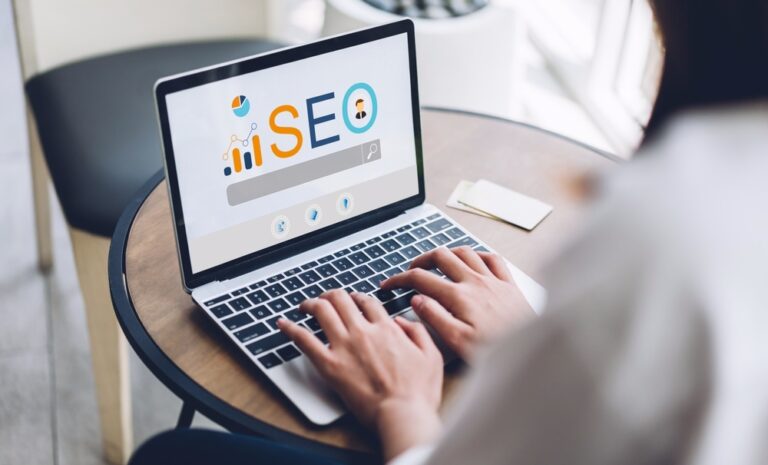When designing or redesigning your website, it can be easy to forget about search engine optimisation (SEO), and instead focus entirely on the design itself. But this is a mistake.
SEO should be involved in the design process from the beginning. Sure, a top web design is very important; but design alone won’t win you new business. SEO has the power to bring in new customers, and ensure they find exactly what they are searching for from your brand.

Why do I need SEO from the start?
Why exactly does your business need a new website in the first place? To attract new customers, increase sales, and generally have a better presence online. Sound about right?
SEO can help with all of those, and that’s why it’s essential to have SEO in mind from the very beginning. If you ignore SEO when designing a website, you will lose track of what it is that your business is trying to achieve.
Shouldn’t web design come first, with SEO coming next?
When you’ve decided to build a new site, remember to not focus only on what you can actually see.
Although a website should always be aesthetically pleasing and easy to use, this isn’t the only part of good web design. SEO needs to be ingrained from the beginning; as doing so can inform the website design itself, and how you expect users to navigate around your site.
Assess Your Current SEO standing
So you’re looking to redesign your website, that’s good going. But how does your business currently fare online, and how can you improve?
Any top web design will take what you currently do well, and what you do poorly, and improve upon both. Design alone cannot change this.
Say your business is great at attracting customers, but poor at converting them into sales. The design can certainly help in improving upon the marketing funnel, and enticing users to take a specific path.
But what about if all your traffic is directed at your home page? Perhaps customers are not finding what they’re looking for, and then choosing a competitor. Well, if you include SEO from the beginning, you can create and optimise individual pages for individual purposes; which would quickly address the problems of specific subsets of users.
Read more here: 20 Top SEO Tools to Increase Your Site Traffic
Save vital time
If you build a website first, and then decide to optimise the website for search engines afterwards, it can often be a costly and time-consuming endeavour. That doesn’t mean it isn’t possible, as it’s definitely a worthwhile cause. However, starting out with SEO in mind when creating a new website can save both time, money, and provide an optimal experience for potential customers.
Alongside this, if you are designing the website after considering SEO, you are going to save a lot of time in coding it itself. There will be less need to return and revisit certain elements of your website, and no need to change anything in the design later on. Also, it will save a lot of time when it comes to bug fixing.
What can be improved?
By considering your SEO needs from the very beginning, there are a number of factors you can improve.
Designing with SEO in mind can have a number of benefits, as your website won’t be made to just look pleasant, but also to fulfil the end aim that your business wishes to achieve. These benefits include:
- How customers find your website via search
- Website navigation
- How well customers understand your site content
- Web design layout and functionality
- Clarity
- Website structure
- Meta descriptions and title tags
- Website content
For more information, read our blog here: Main your SEO Ranking after a Website Redesign
How do I go about ingraining SEO from the start?
You’ll need to assess what currently works and what doesn’t. Take a step back, and do a full audit of your existing website.
Assess and note the following about your existing site:
- Number of visits and visitors per month
- Top ranking keywords
- Total pages indexed
- Top performing pages
- Number of inbound links
Afterwards, consider which of these presents the most value to your business, and how SEO could help you improve on these.
When it comes to building the new website, consider the following:
- Structure or restructuring of the website
- How customers will come across and understand site content
- URL structures for important pages, products or services
Bonus: Mobile-Friendly Ranking Boost – Responsive Web Design
What has become apparent in 2015, is that Google is keen to promote mobile-friendly websites. So much so, that Google gives mobile-friendly websites a ranking boost from April 21st; meaning that if your website isn’t mobile-friendly, your competitors could be outranking you online.
This can be prevented if you ingrain SEO from the start; as choosing a mobile-friendly, responsive web design would be the best choice going forward.
A responsive web design won’t only give you a better ranking on Google, but it has a number of other benefits. Benefits which make Google want to rank your mobile-friendly site higher. These SEO benefits include:
- An improve mobile browsing experience
- The same URLs across devices for sharing
- No pinching to zoom due to responsive adjustments
- Google ranking boost
- Lower bounce rate due to improved user experience
- Faster loading times
For more information, read our blog here: Google announces Locale-Aware Crawling for International Website SEO
All in all, if you’re looking to build a competitive website that shines amongst the competition, then SEO needs to be at the heart of everything you do. Web design can improve many things, but SEO will help your customers find you.
If you’d like to discuss optimising your business online, or perhaps are looking to redesign your current website, get in touch with the team here at Xanthos.












